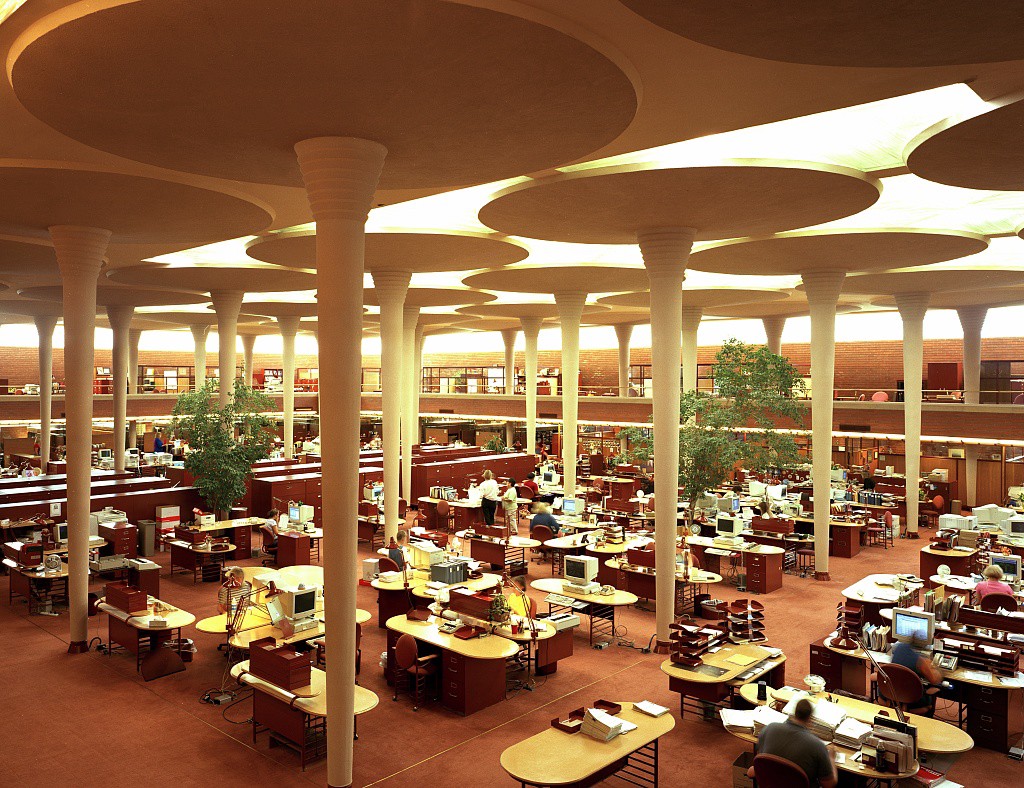Next time you are working, look around. How does the space feel?
This writer in an ad agency wrote about how she felt:
I was forced to trade in my private office for a seat at a long, shared table. It felt like my boss had ripped off my clothes and left me standing in my skivvies.
Lately, the popular trend with U.S. companies has been to arrange employees in an “open-plan” format. This layout has it’s benefits: spontaneous chatter, natural light, free cupcake alerts, or perhaps Friday cocktails served on a wheely-cart. All of these perks work well in an open space and can build camaraderie. I once witnessed a co-worker come in one morning and report having had a great first date to his friend. The whole room burst into applause. However, the open-plan office also lends itself to an array of distractions and a critical lack of privacy. Imagine how many notifications your phone receives in one day, and now multiply that number times the twenty-seven people sitting around you, or imagine a HR person running out to the parking lot to negotiate a salary on her cell phone.
The UK had an open-plan culture involving over 8 million employees for many years. According to a 2016 UK Workplace Survey, 70% of employees have no alternative options for a work-setting within the office.
The survey also reported that 67% of respondents felt drained by the end of the day and that innovators spent just 3.5 days of the week in their offices, highlighting the need for greater flexibility in office design and for remote working.
What About Private Offices?
Perk: If you need to focus or take a call, being in an enclosed room can offer a greater chance of being able to concentrate effectively.
Downer: If your mind tends to wander towards the new West Elm sale or what’s new on your Instagram scroll, being left alone might not be an ideal environment for your productivity.
What About Cubes?
Cubicles actually score the worst for productivity, privacy, and concentration.
Downer: Matthew Davis, a lecturer in socio-technical systems at Leeds University says, (with cubes) “you have most of the problems of the open plan, without the benefits of being able to interact easily with other people.”
Perk: Some people love to have a sealed-off space to call their own.
As you can see, the experience for each individual worker can vary!

Innovation is the byproduct of a healthy workplace. Providing discrete spaces for individuals or groups to work is key.
How To Design A Healthy and Innovative Office
Healthy workplaces exude flow and freedom. They have a relaxing, breathable quality. The noise level signals activity, but the sounds are not distracting. If someone needs to recharge, there’s an option to go outside and connect with nature. The HVAC systems are designed with consistent airflow and temperature balance.
Most importantly, employees are empowered to choose an area to work depending on the role or task they need to accomplish. According to Gensler, one of the leaders in workplace design, there are five work modes to account for:
- Focus: Individual work requiring concentration
- Collaborate: Working together in a group
- Socialize: Camaraderie, relationship-building with your co-workers
- Learn: A presentation or training from another co-worker
- Rejuvenate: Needing to take a time out to recharge
I explored some built structures which could be brought into an office space to encourage these various work modes:






“We’re wired to be social, but we’re also wired to be individuals. We’re constantly navigating that boundary,” Melanie Redman, design researcher, says. “The stress comes when we don’t have control over how we give our time.”
The idea here is that people love to be grounded yet free. We thrive off of diversity. When our environment doesn’t support our human needs, well-being and innovation are compromised. Without innovation, an organization is running on empty.
The graphic below is from Gensler’s 2016 U.S. Workplace Survey. Innovators are 5x more likely to have workplaces that prioritize both individual and group workspaces!

Having worked in multiple settings, I’ve personally noticed that I focus well in the light buzz of an open-plan office. In addition, I’ve found that I’m much more particular about cleanliness, abundant fresh air, and access to natural light when I need to get things done. Monday through Wednesday, my energy is non-stop and I thrive in an open-plan office setting. However, I often prefer Thursday and Friday to be softer, more social, and to learn something new on these days.
Because I’m aware of my personal preferences, I try to plan accordingly. Of course I’m not always in control of my environment, but I’m aware of how I can control my setting. Awareness is the first step to proactively create a space which supports your best you.
Question: What kind of space do you need to focus, collaborate, learn, socialize, and rejuvenate? How do you mix it up?
Originally published at medium.com


